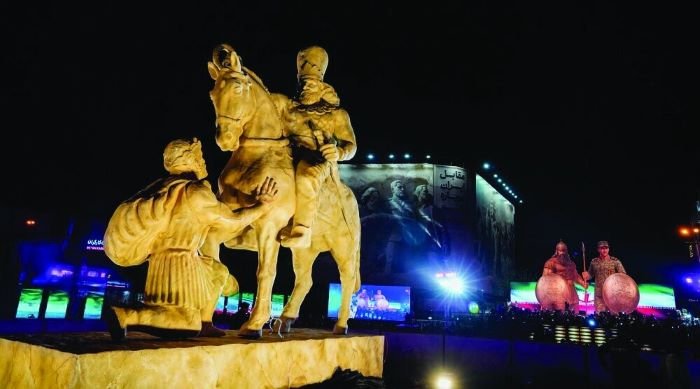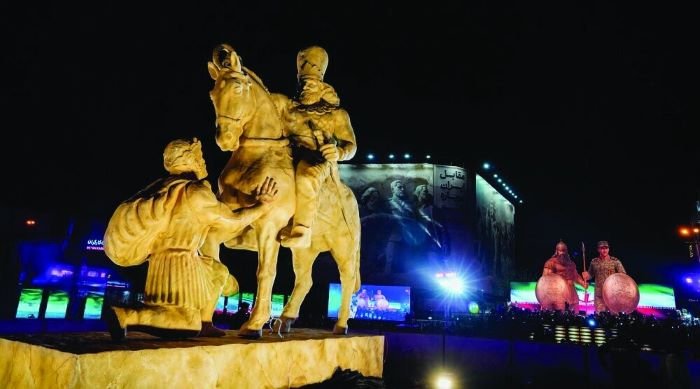
ARABIAN TIMES NEWS NETWORK
Hundreds of people spent their Friday evening at Tehran’s Enghelab Square, awaiting the unveiling of a statue depicting an event from nearly 2000 years ago. As the curtains were pulled away and fireworks began, a carved stone emulating the ancient rock reliefs at the Naqsh-e Rostam archaeological site was revealed. It depicted Iran’s Sassanid King Shapur I seated on a horse, with Roman Emperor Valerian (whom some historians suggest was Philip the Arab) kneeling before him. Behind the statue, a large mural read: “You will kneel again.”
Iran is the oldest continuously existing nation, with a history spanning at least 4,000 years. It is only natural that such a long-lasting civilization has faced many adversaries throughout its history. From 492–490 BC, it was the Greeks; in the 640s CE, the Arab invaders; and in 1219 CE, the Mongols. The Roman Empire served as Iran’s primary rival and enemy for a few centuries of the country’s history, particularly during the Sasanian dynasty. The Tehran statue specifically depicts the Battle of Edessa, which occurred in 260 CE. There is a significant reason why this particular event was chosen for display in Tehran in 2025.
“We have to understand the sheer magnitude of this event. Shapur I achieved what was until then unthinkable,” said Dr. Sorour Khorashadi, Associate Professor and Head of Archaeology at Tarbiat Modares University. “He didn’t just defeat a Roman army; he captured the Roman Emperor himself along with his senior commanders and senators. It was an unprecedented humiliation for Rome and an unparalleled triumph for Iran. Shapur, aware of this legacy, commanded that this victory be made permanent. The rock relief was his answer, and now, this statue continues that act of remembrance.”
This was not an isolated battle, the professor added. It was a pivotal chapter in a much older, grand narrative, which is often seen as an unwritten struggle between East and West that flows from the time of Herodotus and the Persian-Greek wars. “The Roman worldview often saw the East as a space needing ‘civilization.’ The concept of the ‘barbarian’ was used to justify dominance. So, when Shapur forced the proud Emperor to kneel, it was more than a king capturing another king. It was a powerful symbol of Eastern fortitude halting Western expansion. It was, as the relief shows, the descent of Western pride before Eastern fortitude,” Dr. Khorashadi explained.
The idea for the “Defeated Valerian” statue grew out of expert discussions on national identity and how we represent stories of resistance, said Davoud Goudarzi, Deputy of Municipal Services and Environment of Tehran Municipality. “Here at the Municipal Services Department and the Urban Beautification Organization, we’ve long been interested in projects that do more than just fill physical space—we want to imbue the city with cultural meaning,” he explained.
Goudarzi said that during a meeting reviewing designs connected to Iranian-Islamic history, the conversation turned to the battle between the Sassanid King Shapur and Emperor Valerian, and the famous rock carving at Naqsh-e Rostam that commemorates it. “This event is a powerful depiction of Iran’s historical strength. We then collaborated with the renowned artist and sculptor, Mr. Peiman Ghanem, who helped transform this concept into a concrete design. With his deep understanding of history and a command of contemporary artistic language, Mr. Ghanem was able to reinterpret this historical narrative as a modern piece of public art.”
Goudarzi stated that local authorities hope that as Tehran’s citizens pass through Enghelab Square and onward to Azadi Square, they encounter more than just a sculpture. The municipality wants them to experience a living piece of history – a story that connects them to their roots and serves as a powerful reminder that the people of Iran have never bowed, and will never bow, to any foreign power. “Our message is one of dignity, national confidence, and hope. When public art is fused with thoughtful identity, it becomes a powerful voice for a nation’s resilience and strength. Our goal has been to carry this spirit from ancient carvings into the heart of our modern city and remind everyone that Iran is a nation that has always stood strong,” he added.
The citizens gathered at Enghelab Square recently seemed to experience a range of emotions. Pride was certainly one of them. “It’s remarkable how history repeats itself. We struggled with Western powers thousands of years ago, and we continue to do so today,” said Hamed, a 17-year-old high school student who filmed much of the event. “But precisely because history repeats itself, I believe we can once again be victorious. I think the pressure and aggression we experience from the Western world today will subside eventually, just as it did during King Shapur’s reign.”









